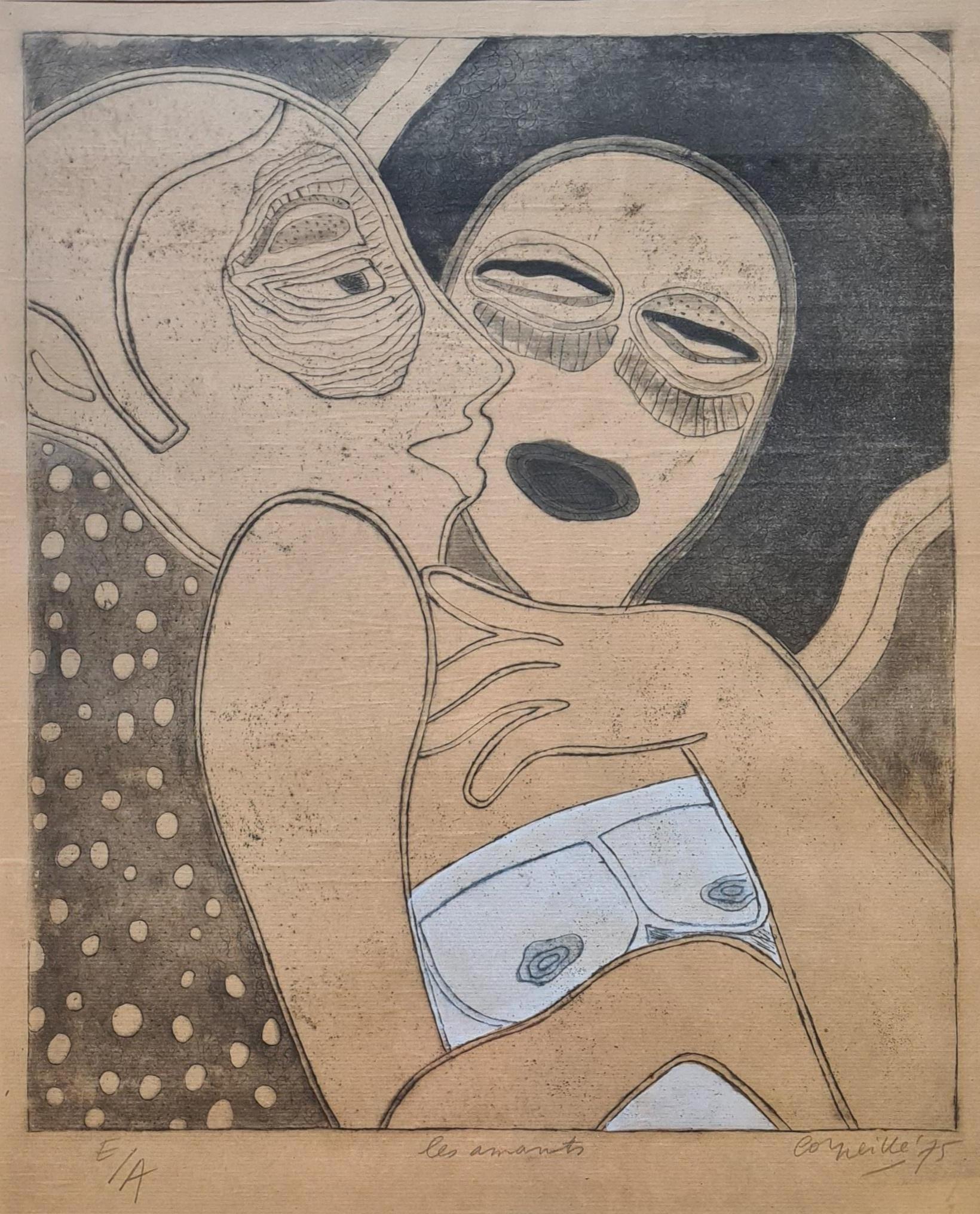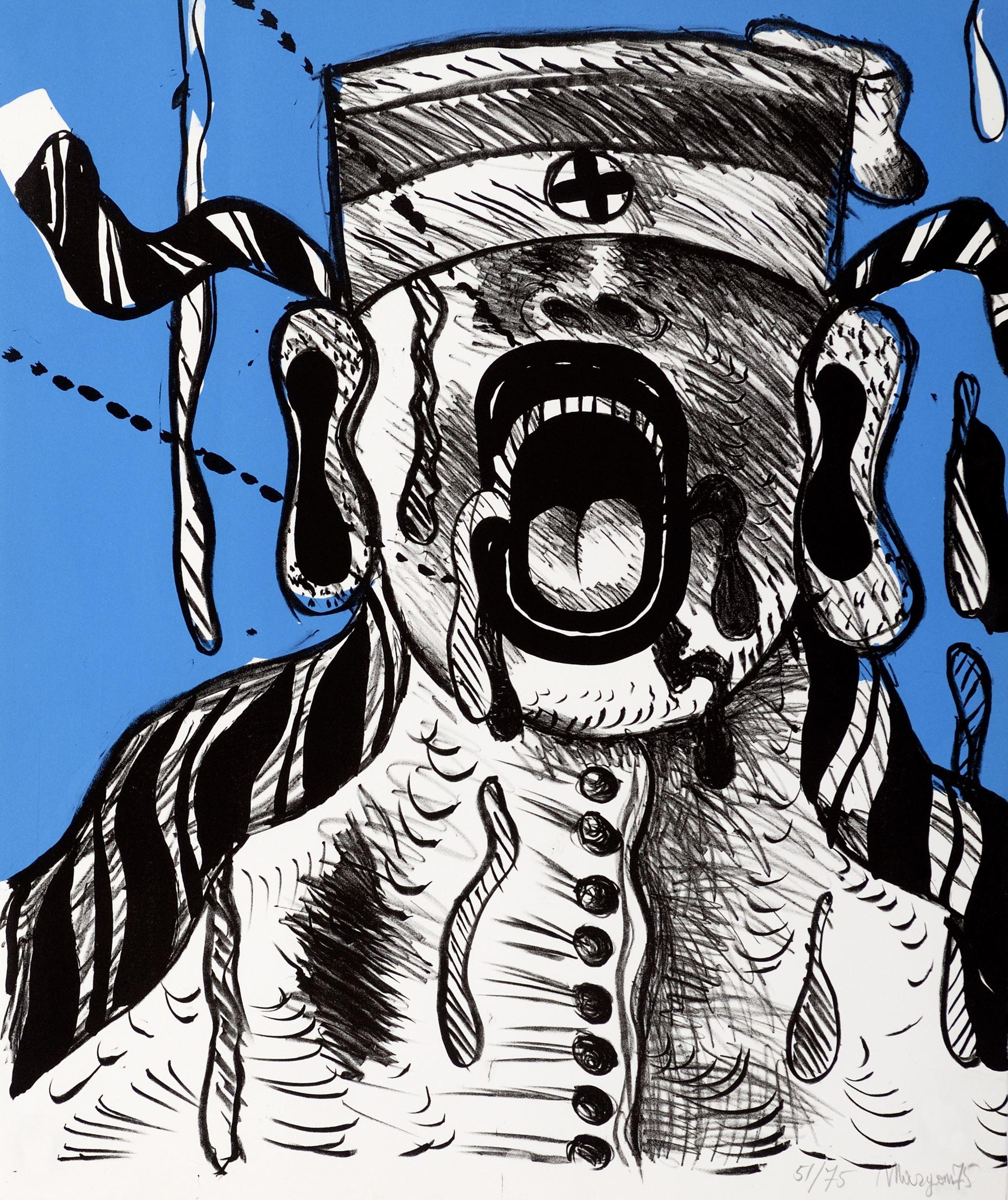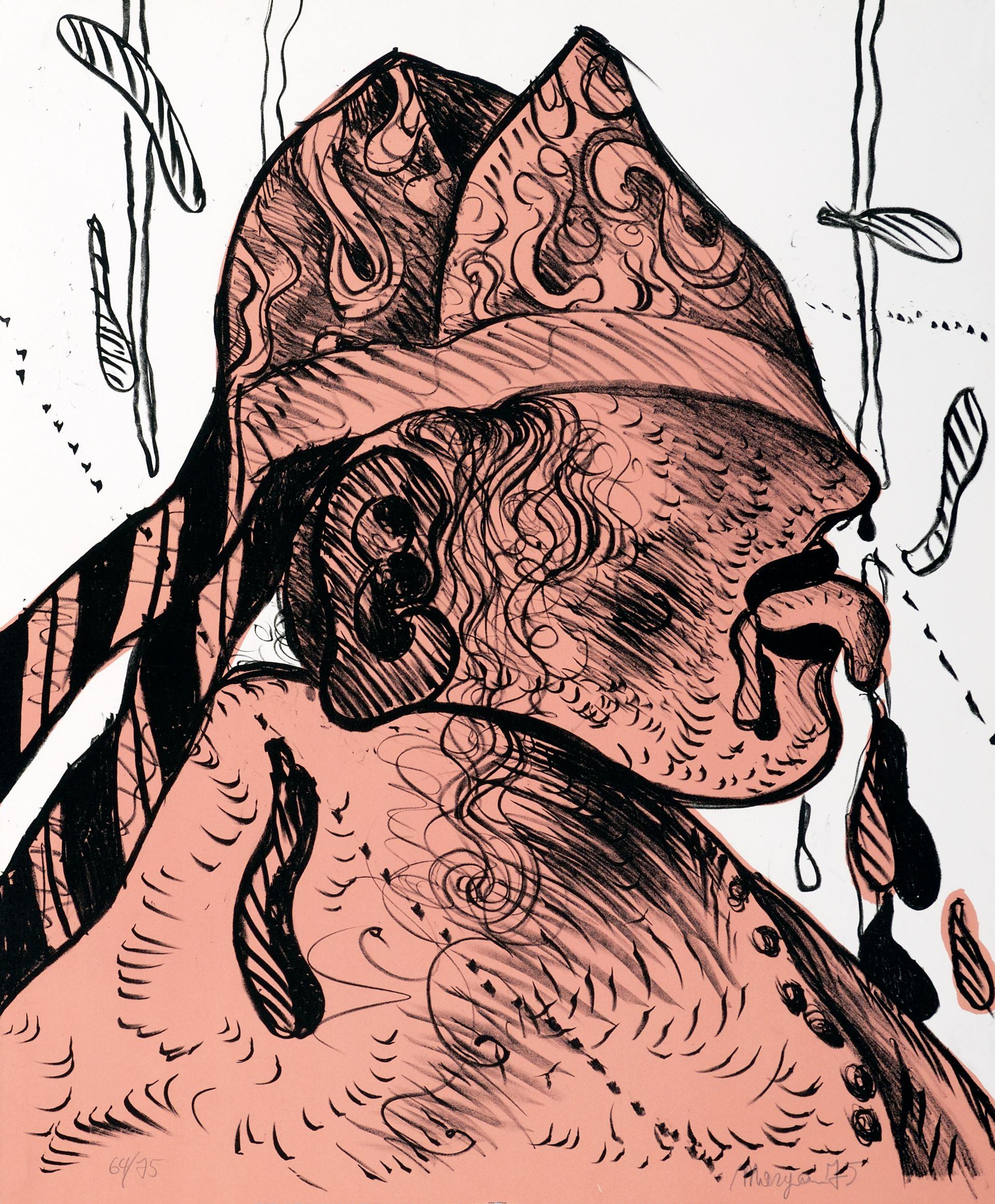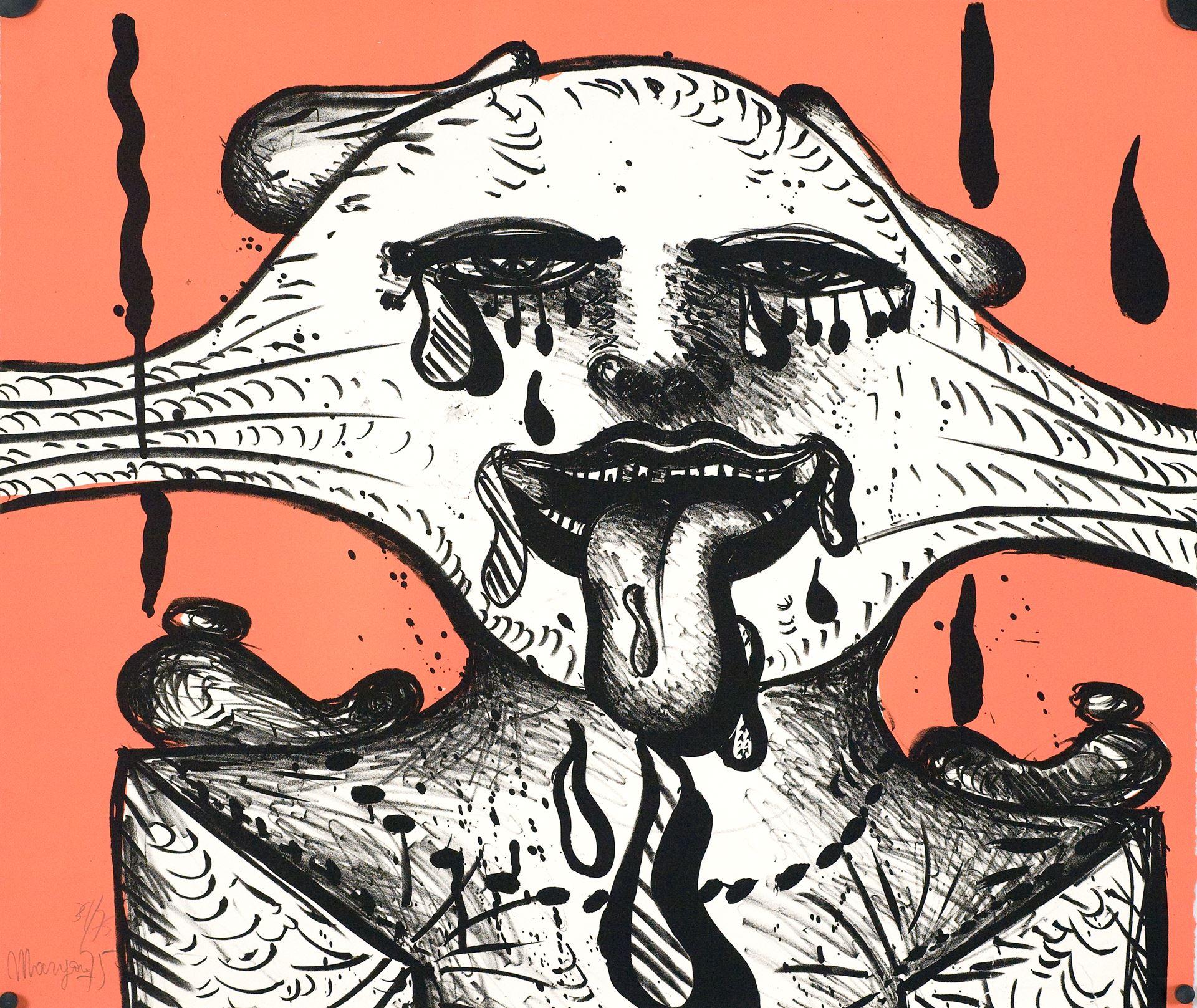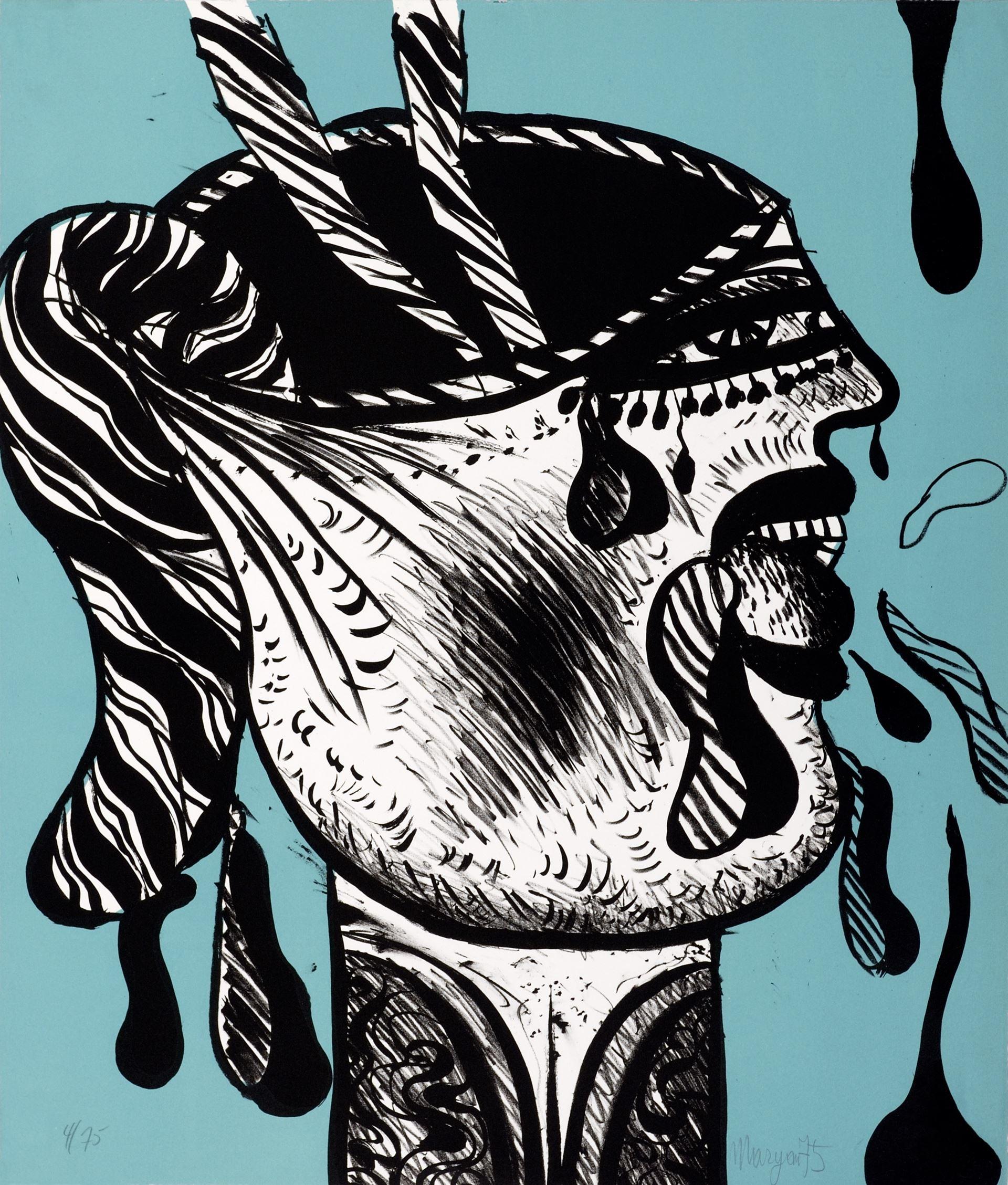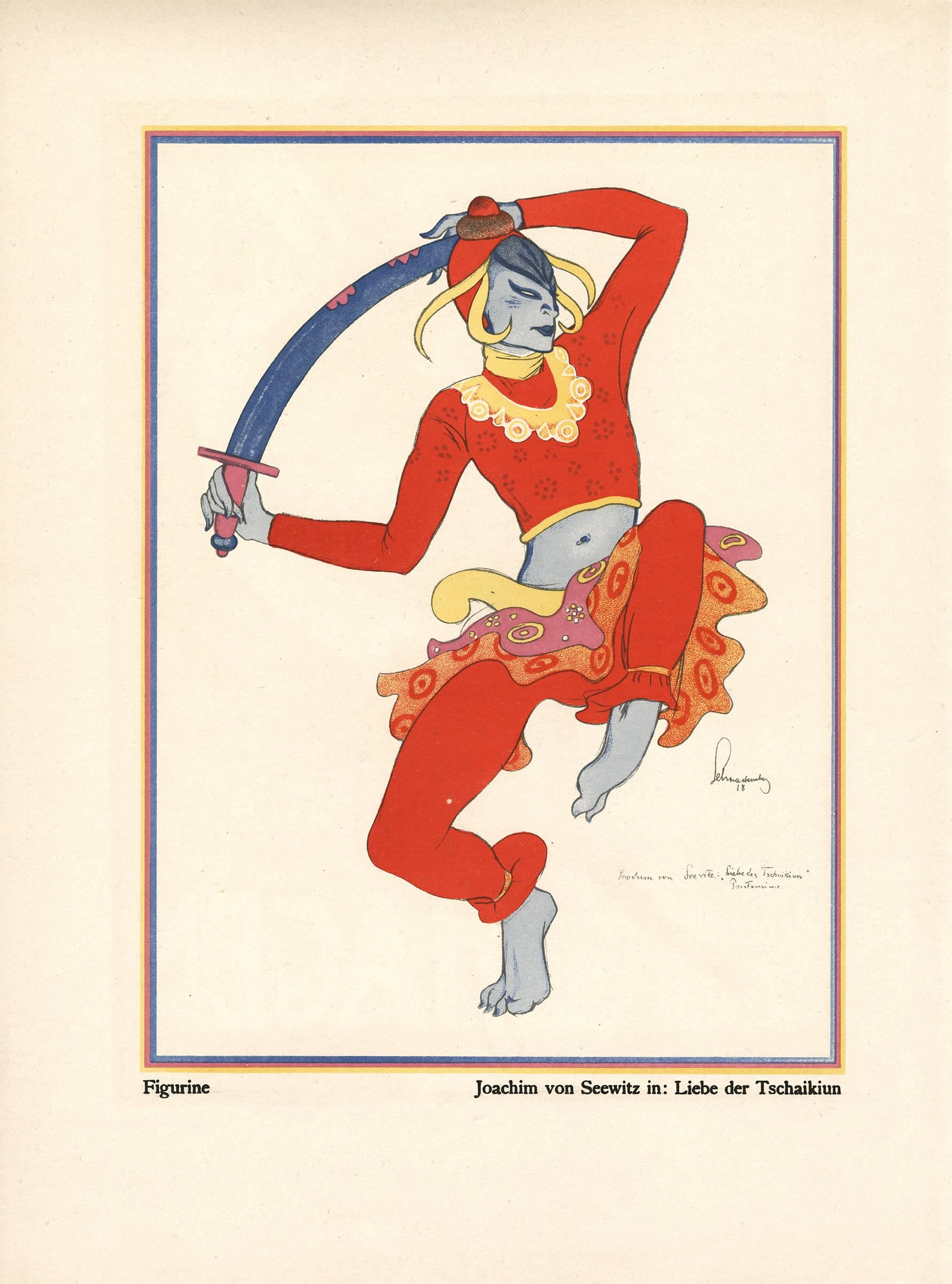Items Similar to Men from Ecce Homo - Original Lithograph by George Grosz - 1923
Want more images or videos?
Request additional images or videos from the seller
1 of 2
George GroszMen from Ecce Homo - Original Lithograph by George Grosz - 19231923
1923
About the Item
Men from Ecce Homo is an original offset and lithograph realized by George Grosz.
The artwork is the plate n. 80 from the porfolio Ecce Homo published between 1922/1923,edition of Der Malik-Verlag Berli, that includes offset lithograph print.
Numbered on plate on lower margin.
Good conditions except for a yellowing of paper due to the time and some minor defects along the margin.
Ecce homo is a selected compendium of 100 artworks (16 watercolors and 84 drawings) that Grosz realized from 1915 to 1922. The book is a real satire of post-war German life, with prostitutes, politicians, mutilated veterans,capitalists, and drunks in different states of despair, lust, and rage. The German government banned his artworks and Grosz was put on trial for public offense.
George Grosz (1893 -1959) was a German artist known especially for his caricatural drawings and paintings of Berlin life in the 1920s. He was a prominent member of the Berlin Dada and New Objectivity group during the Weimar Republic.
He studied drawing at the Dresden Academy 1909-11 and at the School of Arts and Crafts in Berlin 1912-14, He was in the army 1914-15 and again for a short time in 1917, but spent the rest of the war in Berlin where he made violently anti-war drawings, in which his main focus was attacking the social corruption of Germany (capitalists, prostitutes, the Prussian military caste, the middle class).
His artworks had great impact in the Berlin Dada movement 1917-20 and collaborated with John Heartfield and Raoul Hausmann in the invention of photomontage. Many of his drawings were published in albums (Gott mit uns, Ecce Homo, Der Spiesser-Spiegel etc.), and he was subject to prosecutions for insulting the army and blasphemy. Visited the USA in 1932 to teach at the Art Students League, New York, and settled there 1933. In the latter part of his career he tried to establish himself as a pure painter of landscapes and still life, but also painted many compositions of an apocalyptic and deeply pessimistic kind. His role in the Berlin Dada movement affected political outlooks and artistic developments not only in Germany, but also in Russia, the Balkan nations, and parts of France. Grosz's penetrating, darkly humorous style of drawing and his use of satire as a weapon left a deep impression on the work of his contemporaries and the artists of the next generation. Some of his works from the early 1940s, particularly during World War II, do present an allegorical and dramatic representation of Grosz's moral perspective regarding war. Additionally, some of his last pieces from 1958 were photomontages and hearken back to his earlier Dadaist aesthetic and message, passing judgment upon consumerism and suggesting that his absorption with American culture had ended in disappointment. In 1959, Grosz sold his house and moved back to Berlin. He died shortly after his return, after a fall down the stairs.
- Creator:George Grosz (1891-1969, German)
- Creation Year:1923
- Dimensions:Height: 13.98 in (35.5 cm)Width: 9.65 in (24.5 cm)Depth: 0.04 in (1 mm)
- Medium:
- Movement & Style:
- Period:
- Framing:Framing Options Available
- Condition:Insurance may be requested by customers as additional service, contact us for more information.
- Gallery Location:Roma, IT
- Reference Number:
About the Seller
4.9
Platinum Seller
These expertly vetted sellers are 1stDibs' most experienced sellers and are rated highest by our customers.
1stDibs seller since 2017
6,705 sales on 1stDibs
Typical response time: 2 hours
- ShippingRetrieving quote...Ships From: Grasse, France
- Return PolicyA return for this item may be initiated within 14 days of delivery.
More From This SellerView All
- They Thunder forth from Their Clouds-Lithograph by George Grosz - 1922By George GroszLocated in Roma, ITThey Thunder forth from Their Clouds is an original lithograph, realized by George Grosz in 1922, from Die Raüber, edition Malik Verlag in 100 prints, plate n°8 da Die Raüber, hand-signed in pencil. "They thunder forth from their clouds about gentleness and forbearance, while they sacrifice human victims to the God of love." (Da donnern sie Sanftmut und Duldung aus ihren Wolken und bringen dem Gott der Liebe Menschenopfer.)" Sheet dimension: 61,5 x 42 cm. In very good conditions. Here representing a man in front of cross miserably praying, below of his feet laid down many dead bodies and ruined part of the city. here is one of his artwork affected by consequences drama of war. George Grosz (1893 -1959) was a German artist known especially for his caricatural drawings and paintings of Berlin life in the 1920s. He was a prominent member of the Berlin Dada and New Objectivity group during the Weimar Republic. He studied drawing at the Dresden Academy 1909-11 and at the School of Arts and Crafts in Berlin 1912-14, He was in the army 1914-15 and again for a short time in 1917, but spent the rest of the war in Berlin where he made violently anti-war drawings...Category
1920s Expressionist Figurative Prints
MaterialsLithograph, Paper
- Better People - Original Offset and Lithograph by George Grosz - 1923By George GroszLocated in Roma, ITBetter People from Ecce Homo is an original offset and lithograph realized by George Grosz. The artwork is the plate n.8 from the portfolio Ecce Homo published between 1922/1923, e...Category
1920s Expressionist Figurative Prints
MaterialsLithograph, Paper, Offset
- In Thought - Original Offset and Lithograph by George Grosz - 1920By George GroszLocated in Roma, ITIn Thought is an original offset and lithograph print realized by George Grosz. The artwork is the plate n. 37 from the portfolio Ecce Homo published between 1922/1923, edition of D...Category
1920s Expressionist Figurative Prints
MaterialsLithograph, Paper, Offset
- Hard Times - Original Offset and Lithograph by George Grosz - 1923By George GroszLocated in Roma, ITHard Times from is an original offset lithograph realized by George Grosz. The artwork is the plate n.27 from the portfolio Ecce Homo published between 1922/1923, edition of Der Ma...Category
1920s Expressionist Figurative Prints
MaterialsPaper, Offset, Lithograph
- Bereaved - Original Offset and Lithograph by George Grosz - 1923By George GroszLocated in Roma, ITBereaved is an original offset and lithograph realized by George Grosz. The artwork is the plate n. 13 from the portfolio Ecce Homo published between 1922/1923, edition of Der Malik...Category
1920s Expressionist Figurative Prints
MaterialsLithograph, Offset, Paper
- Family - Offset and Lithograph by George Grosz - 1923By George GroszLocated in Roma, ITFamily is an original offset and lithograph print realized by George Grosz. The artwork is the plate n. 2 from the portfolio Ecce Homo published between 1922/1923, edition of Der Ma...Category
1920s Expressionist Figurative Prints
MaterialsLithograph, Paper, Offset
You May Also Like
- CoBrA, Signed Limited Edition Lithograph, L'épreuve d'Artiste 'Les Amants'By Guillaume Cornelis van Beverloo (Corneille)Located in Cotignac, FRSigned limited edition lithograph, 'Les Amants', by Belgian/Dutch artist, Corneille. This is the artists own copy, L'épreuve d'artiste, from the edition of 40, Vincenzo Bitetti, Potenza of the rarer monochromatic version. Eau forte and aquatinte on craft paper with white highlights added. It is signed titled and dated in pencil by the artist. Presented in patinated wood frame under glass. Corneille was the pseudonym of Guillaume Cornelis van Beverloo, born July 4, 1922 in Liège (Belgium), of Dutch parents, and died in Auvers-sur-Oise (Val-d'Oise) September 5, 2010, he was a Dutch painter, engraver, sculptor and ceramist After attending the School of Fine Arts in Amsterdam, Corneille began exhibiting in 1946, then discovered surrealism. Co-founder in 1948 with Karel Appel, Eugène Brands, Constant Nieuwenhuis, Anton Rooskens and Theo Wolvecamp, of the Experimentele Groep in Holland movement which publishes the journal Reflex, anticipating the magazine Cobra (journal) which would appear the following year in Denmark, Belgium, then in the Netherlands. He is one of the initiators of Cobra with Karel Appel, Constant Nieuwenhuis, Asger Jorn and Dotremont. This group was soon joined by poets, painters and writers including Jacques Doucet, Pierre Alechinsky, Henry Heerup, Reinhoud, Else Alfelt, Carl-Henning Pedersen, Egill Jacobsen, C.O. Hultén, Anders Osterlind...Category
1970s Expressionist Figurative Prints
MaterialsPaper, Watercolor, Black and White, Lithograph
- Pinchas Burstein ¨Maryan¨, "Untitled", 1975, Lithograph, 24.4x20.9 in n1By Pinchas MaryanLocated in Miami, FLPinchas Burstein ¨Maryan¨ (Polonia, 1927-1977) 'Sin título (azul)', 1975 Lithograph on paper 24.5 x 20.9 in. (62 x 53 cm.) Edition of 75 ID: BUR1102-001-075Category
1970s Expressionist Prints and Multiples
MaterialsPaper, Etching, Screen, Lithograph
- Pinchas Burstein ¨Maryan¨, "Untitled", 1975, Lithograph, 24.4x20.9 in n3By Pinchas MaryanLocated in Miami, FLPinchas Burstein ¨Maryan¨ (Polonia, 1927-1977) 'Sin título (rosa)', 1975 Lithograph on paper 24.5 x 20.9 in. (62 x 53 cm.) Edition of 75 ID: BUR1102-003-075Category
1970s Expressionist Prints and Multiples
MaterialsPaper, Etching, Screen, Lithograph
- Pinchas Burstein ¨Maryan¨, "Untitled", 1975, Lithograph, 20.9x24.4 in n4By Pinchas MaryanLocated in Miami, FLPinchas Burstein ¨Maryan¨ (Polonia, 1927-1977) 'Sin título (carmín)', 1975 Lithograph on paper 20.9 x 24.5 in. (53 x 62 cm.) Edition of 75 ID: BUR1102-004-075Category
1970s Expressionist Prints and Multiples
MaterialsPaper, Etching, Screen, Lithograph
- Pinchas Burstein ¨Maryan¨, "Untitled", 1975, Lithograph, 24.4x20.9 in n2By Pinchas MaryanLocated in Miami, FLPinchas Burstein ¨Maryan¨ (Polonia, 1927-1977) 'Sin título (verde)', 1975 Lithograph on paper 24.5 x 20.9 in. (62 x 53 cm.) Edition of 75 ID: BUR1102-002-075Category
1970s Expressionist Prints and Multiples
MaterialsEtching, Lithograph, Paper, Screen
- Kostume, Plakate, und Dekorationen, "Joachim von Seewitz"By Walter SchnackenbergLocated in Chicago, ILWalter Schnackenberg’s style changed several times during his long and successful career. Having studied in Munich, the artist traveled often to Paris where he fell under the spell of the Henri de Toulouse-Lautrec’s colorful and sensuous posters depicting theatrical and decadent subjects. Schnackenberg became a regular contributor of similar compositions to the German magazines Jugend and Simplicissimus before devoting himself to the design of stage scenery and costumes. In the artist’s theatrical work, his mastery of form, ornamentation, and Orientalism became increasingly evident. He excelled at combining fluid Art Nouveau outlines, with spiky Expressionist passages, and the postures and patterns of the mysterious East. In his later years, Schnackenberg explored the unconscious, using surreal subject matter and paler colors that plainly portrayed dreams and visions, some imbued with political connotations. His drawings, illustrations, folio prints, and posters are highly sought today for their exceedingly imaginative qualities, enchanting subject matter, and arresting use of color. SCHNACKENBERG: KOSTUME, PLAKATE UND DEKORATIONEN, a cardboard bound art book consisting of 43 prints of work by Walter Schnackenberg, 30 of which are color lithographs that are signed and some are titled and dated in the plate, as well as black and white prints and photographs with accompanying text by Oskar Bie; lithographs printed at Kunstanstalt Oskar Consee in Munich, other images printed by Gesellschaft Pick & Co. in Munich, the text and cover with color images by Schnackenberg front and verso printed by R. Oldenbourg in Munich; published by Musarion Verlag, Munich, 1920. The majority of Walter Schnackenberg’s artistic output was destroyed by bomb attacks in Munich in 1944. The highly publicized 2013 auction in New York of the recovered pre-war poster collection once belonging to German poster aficionado, Hans Sachs has reintroduced the world to Walter Schnackenberg’s graphic genius and priceless ephemeral art from a lost era. Besides the museum world, designer Karl Lagerfeld is one of the most prodigious collectors of Schnackenberg. Flipping through the pages of Kostume, Plakate und Dekorationen, it becomes quite clear that Schnackenberg’s collection is ground zero at the crossroads of early modern fashion where the cult of celebrity meets up with dance, music, theater and cabaret, film and the graphic medium. Berlin and Munich under Germany’s Weimar Republic in the first quarter of the 20th century produced just the atmosphere to feed this burgeoning industry. Rising inflation sparked a recklessness to live large for the moment and heightened a desire for escapism. An influx of Indian and East Asian dancers and musicians added to the artsy bohemian cultural mix. A new decadence and tolerance resulted. Film boldly featured provocative subject matter. Cabarets became popular venues giving rise to the demi-monde in which people from all social stations mixed more freely in a thriving underground economy and culture where there was a blurring of boundaries and of social codes. Noted art historian and cultural doyen, Oskar Bie astutely observes in his introduction to Schnackenberg’s publication that what unites the images is fantasy and advertisement. Schnackenberg uses the eye as an instrument to brilliantly construct and convey this double message. His personages never directly confront the viewer. Their eyes gaze off in the distance like those of the screenplayer and film star Hedamaria Scholz in Schnackenberg’s “Die Rodelhexe” movie poster. Their eyes follow the path of a dance composition or become a transfixed and ogling male gaze such as the iconic 1911 Odeon Casino...Category
1910s Expressionist Figurative Prints
MaterialsPaper, Lithograph
